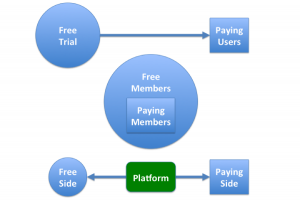The following is Part VI of a multi-part series on value, segmentation and pricing by guest contributor Steven Forth, Partner at Rocket Builders and eFund Member. Read Part I here, Part II here, Part III here, Part IV here, and Part V here. Steven was recently called out as one of the top experts in B2B software pricing by OpenView Labs in Boston.
 Pretty much anyone delivering software today is expected to have some kind of free offer. There is even a popular book on the topic Free: The Future of a Radical Price by Chris Anderson. There are free copies of this book available if one pokes around a bit (I bought my copy, as I like authors to get paid so they will write more books, and I like having the physical objects around.)
Pretty much anyone delivering software today is expected to have some kind of free offer. There is even a popular book on the topic Free: The Future of a Radical Price by Chris Anderson. There are free copies of this book available if one pokes around a bit (I bought my copy, as I like authors to get paid so they will write more books, and I like having the physical objects around.)
According to classical economics, the price of anything should trend towards its marginal cost (the cost of producing and delivering an additional unit). And the marginal costs of most cloud-based software approach zero.
So will all digital content, cloud software and anything else where the marginal cost approaches zero see prices trend down and down to almost nothing? If that is the case, a lot of us are going to have to rethink our business models.
In fact there are many different flavours of free software. To win at this game you have to have a clear understanding of the different reasons software is provided for free. And know which of these approaches you are executing on.
It all started with ‘free software.’ The free software movement was a big deal in the 1980s and 1990s, and is still active today, led by Richard Stallman and the Free Software Foundation. Basically people give away software, including the source code, in to support the general good. They are encouraged to do this by the hope of getting some paid services or a job. This is how open source software works (the Free Software Foundation manages the GNU General Public License, one of the standard ways to license open source software). Free software sparked the current wave of free options, but it does not describe what most companies are trying to do today.
In commercial terms there are three main business models for free software: free trial, free community and two-sided markets.
Free Trial
Most people today expect to try before they buy. And with cloud software this is easy to accommodate. So almost all software companies are going to provide some form of free trial. The question becomes how do I design this to maximize the conversion from free to paid? This is not easy to figure out. One has two basic things to play with – ‘What functionality do I provide?’ and ‘How long should a trial last?’
What functionality to provide? The simple answer is ‘enough to demonstrate your core value propositions and to provide some (but not too much) value to the user.’ The challenge is figuring out just what functionality demonstrates enough value. This is a real challenge when the value provided is different across segments.
How long should a trial last? Again, the answer is ‘long enough for the user to understand the value, but not so long that they capture most of the value during the trial or so long that the attraction of the new and shiny object begins to wear off.’
You have to do more than show what the software does. You have to help the user understand how they will get long-term value. If you have a product that provides a solution to a one-off problem, you also have to find a way to prevent all of the value from being captured during the trial.
With free trials you are trying to optimize your conversion metrics. How many of the trial users convert to paying users? This conversion number is likely to be low, lower than you expect, almost certainly less than 10% and probably less than 3%! You already A/B test your home page, and you are going to need to find ways to A/B test your free trial offer to see what optimizes conversion metrics.
Free Community
With social software becoming a part of all sorts of different software, even dry business applications like accounting where leading providers are working hard to build user communities that connect in directly to their applications. In many cases, the more members of the community the more valuable the community is for all users, an example of the network effect (or Metcalfe’s law if you prefer). So as a provider you want to grow your overall community in order to provide more value to your paying users.
You still have the challenge of converting at least some of the community to paying users. (How many of us pay for our LinkedIn accounts?) There have to be some additional value propositions for the paying members.
A number of common models are emerging for how to provide additional value for a subset of paying members: analytics and visualization about the community; information about or the ability to reach out to community members one or more degrees removed from you; paying for privacy. Again the trick is to make sure that you create value for all community members while finding very specific forms of value for segments of the community that you want to convert to paying users (professional users, and sales users on LinkedIn for example).
Two-Sided Market
Two sided markets, or platform businesses, are one of the most powerful business models (and the most difficult to pull off). The classic example is the credit card business, in which the credit card company, which has the platform, provides services to both consumers who want to buy something and merchants who have something to sell. In this case the platform providers usually monetize (extract money from) both sides of the market, but this does not have to be the case.
Google Search plus Google Adwords is another two-sided market, perhaps the most successful in recent history. Google Search is offered for free while advertisers pay to have short text advertisements placed in response to searches. We are happy because we get a powerful search service for free. The advertisers are happy because the pay-per-click pricing model gets them closer to knowing how much value they are getting from their advertising.
A two-sided market is the most powerful business model. And if you have a conventional business model it can be very difficult to compete with, especially if you are trying to sell to the side of the market that someone else is providing a free service to. Of course it is not easy to succeed with this model. It is hard enough to build one market, let alone two.
Deciding how to monetize each side of the market is the critical question. In most cases one side of the market will be getting more concrete value than the other (as in the Google example), or one side will be easier to sell to, or one side will be a much larger potential market than the other. These differences can all help you decide which side of the market to monetize.
So there are at least four common models for offering your software for free:
- Offer free software and sell services
- Get people to try out your software for free and then convert them to paying users
- Build a community and then monetize subsets of that community
- Create a two-sided market
Unfortunately, there is a fifth ‘model’ that I see all to often. There are companies that are offering free software or services because they don’t know how to sell them, or because they don’t create enough value for anyone to pay money for. But that is not really a business model. A business model is how you create value for customers and then capture enough of that value to reinvest in innovation and grow your business. Giving it away will not do the trick.
 Steven Forth is a Vancouver consultant, investor and serial entrepreneur. He is a partner at Rocket Builders where his work is focused on market strategy including market segmentation, pricing and the design of revenue generation systems. He invests through eFund where he occasionally leads due diligence teams. His newest venture is TeamFit, a VentureLabs start-up building a platform for team building and collaboration.
Steven Forth is a Vancouver consultant, investor and serial entrepreneur. He is a partner at Rocket Builders where his work is focused on market strategy including market segmentation, pricing and the design of revenue generation systems. He invests through eFund where he occasionally leads due diligence teams. His newest venture is TeamFit, a VentureLabs start-up building a platform for team building and collaboration.
